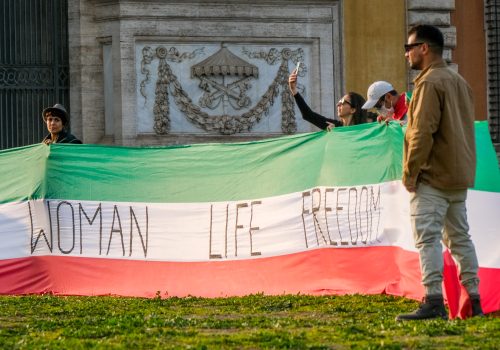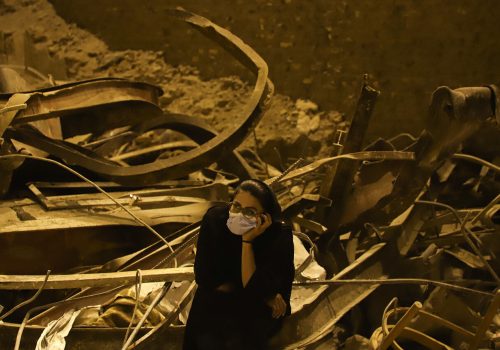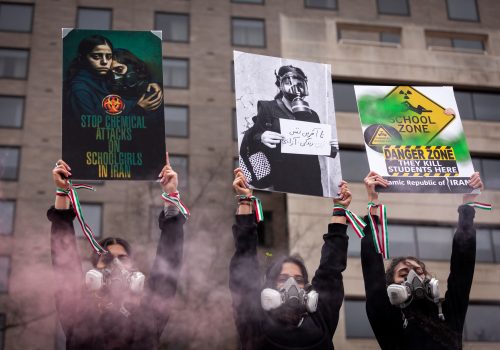The State Department is fumbling its approach to Iran. It’s time for an overhaul.
“It is clear to us that the meaning of diplomacy means compromising with the clerics of the Islamic Republic—if they didn’t have backing like you, they wouldn’t have survived,” wrote an Iranian in response to a quote by President Joe Biden posted on April 10 on the official Persian language US State Department Instagram (@usabehfarsi).
Even without knowledge of Persian, anyone can click “see translation” to read the frustration and slew of insults in the replies of the account with over 684,000 followers. Some might dismiss these comments as belonging to members of the diaspora or even bots, but many appear to be real Iranians living inside Iran.
Many Iranians, whether in the diaspora or inside the country, are angry and dissatisfied with the United States’ policy toward the Islamic Republic. Since taking office in January 2021—and particularly since the mid-September 2022 anti-establishment protests that occurred after the murder of Mahsa Jina Amini—the Biden administration has imposed countless sanctions, covering everything from terrorism to human rights abuses. Meanwhile, the State Department’s social media accounts—which are run by the Office of Iranian Affairs—have taken the safe route. They repost official US government statements and share Iranian holiday greetings. Most of all, they continue to make soft power gestures, such as posting messages about Women’s History Month and Space Diplomacy Week.
These messages are innocuous, but they don’t resonate with Iranians, as the content doesn’t match with what’s happening on the ground. It lacks empathy and misses the serious concerns of Iranians, who feel the world has forgotten their plight. The US State Department should adopt a new approach by overhauling its current messaging strategy.
Eighty-four percent of Iranians over the age of eighteen use social media and messaging apps—many of which have to be accessed through circumvention tools like Virtual Private Networks (VPNs). The photo-sharing app, Instagram, is the most popular among Iranians and one of their primary forms of information gathering. With that in mind, @usabehfarsi should not just focus on official US government statements but highlight the human rights situation on the ground, such as the alarming rise in executions across the country in recent weeks; ongoing mass poisonings of school girls; the plight of imprisoned dissidents like rapper Toomaj Salehi; and the families under pressure to remain silent after their children were murdered, like nine-year-old Kian Pirfalak, who was gunned down by security forces.
While the international news cycle focuses its attention elsewhere, the protests in Iran are not dead. In fact, they have been going on continuously since mid-September 2022. The clerical establishment is walking through a minefield of public anger and resentment, and it’s only a matter of time before it makes another wrong move and people pour back into the streets en masse. There’s no going back to the days when mass protests were a once-in-a-decade anomaly, such as the 1999 student uprisings or the 2009 post-election protests known as the Green Movement. Iranians are fed up with the status quo and want the Islamic Republic gone, and their protests have become normalized as a result.
Some may raise concerns that the US government will be seen as meddling in Iranian affairs by turning its focus to the situation on the ground. But, regardless of what the United States does, it always gets the blame. Take Supreme Leader Ayatollah Ali Khamenei’s Nowruz address on March 20, in which he dismissed the ongoing anti-establishment protests as “riots” that are part of a “global conspiracy” led by the United States. More importantly, the strength of the “meddling” narrative has long faded among many Iranians going back to the 2009 Green Movement, when protesters chanted, “Obama, Obama—either you’re with them [referring to the clerical establishment] or you’re with us.” It’s also worth noting that, at every opportune moment, Iranian officials have regularly weighed in on what’s happening in the United States, such as the Black Lives Matter movement.
Messaging doesn’t just pertain to social media. It’s also essential that the State Department has a representative that is regularly at the disposal of Western and Persian language diaspora media outlets to take questions and engage with Iranians of all stripes on social media and in the diaspora on an array of Iranian issues.
The mandate of Robert Malley, the US Special Envoy for Iran—which operates separately from the Office of Iranian Affairs—was to revive the 2015 Joint Comprehensive Plan of Action (JCPOA) that the Donald Trump administration withdrew from in May 2018 (despite Tehran not violating the multilateral nuclear deal at the time). But priorities and times have changed. The revival of the JCPOA hasn’t happened for an array of reasons, starting with Tehran not coming to the table since August 2022. It isn’t likely to happen, either, given Iran’s provision of armed drones to Russia for the Ukraine conflict and their brutal crackdown on anti-establishment protesters. It’s time that Malley be replaced with a fresh face—preferably someone who focuses on an array of issues beyond the nuclear file, that may also speak Persian, and whose reputation isn’t built on the revival of the JCPOA alone.
The Biden administration’s approach must be more forthright to demonstrate that they are hearing the people of Iran and won’t forget them. There are embers of anger burning in Iran and the last thing any US administration would want to do is suggest that they aren’t paying attention when it spreads like a wildfire again. The United States must be on the side of the people of Iran. Otherwise, Iranians won’t forget who was on the wrong side of history when change does come.
Holly Dagres is a nonresident senior fellow in the Atlantic Council’s Middle East programs and editor of the Atlantic Council’s IranSource blog. She is also the author of the “Iranians on #SocialMedia” report. Follow her on Twitter: @hdagres.
This article was updated on May 22, 2023 to clarify that the State Department’s Office of the Special Envoy would not have jurisdiction over Persian-language social media messaging, which is under the Office of Iranian Affairs.
Further reading
Thu, Feb 23, 2023
Iran’s ‘women, life, freedom’ revolution has a manifesto. Here are the next steps.
IranSource By
Signed by twenty organizations and released on February 13, the manifesto gathered the support of many civil society organizations in Iran.
Wed, Jun 8, 2022
‘From Cinema Rex to Metropol,’ Iranians have had enough
IranSource By
On May 23, a ten-story commercial tower came crashing down on people’s heads in Abadan. With each body recovered from the ruins, public anger crescendoed, leading to ongoing street protests in multiple areas in Khuzestan province and beyond.
Tue, May 2, 2023
Schoolgirl poisonings are persisting in Iran. So should the international reaction to them.
IranSource By
The international community must take decisive and expeditious measures to ensure accountability and safeguard the human rights of Iranian citizens, especially women and girls.
Image: Iranian-Americans link hands around the U.S. State Department in Washington, D.C. during a protest on March 4, 2023. Members of the Iranian community called for the firing of Robert Malley, special U.S. envoy for Iran, accusing him of failing to enforce sanctions and misrepresenting the demands of anti-regime demonstrators. (Photo by Alejandro Alvarez/Sipa USA)


